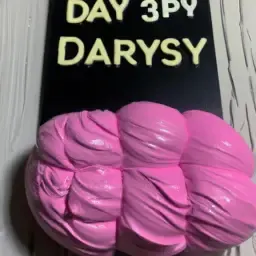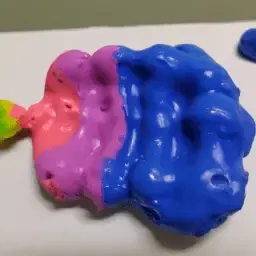This site is supported by our readers. We may earn a commission, at no cost to you, if you purchase through links.
Puffy paint, the preferred paint of crafters, is a fun thing to use for creative home projects. However, waiting for puffy paint to dry can be a complicated process, and knowing how long it takes to dry is essential to creating great puffy masterpieces.
In this article, we will discuss the various factors that affect puffy paint’s ability to dry, the quickest ways to dry it, and the estimated drying times of puffy paint under different crafting conditions.
Table Of Contents
The Basics of Puffy Paint Drying
 Puffy paint is a fabric-based paint that is used to create a raised, cloud-like look on fabrics, wood paneling, and other materials. Puffy paint is made up of various chemicals and plastics that create a distinct texture, and it can come in a variety of possible colors.
Puffy paint is a fabric-based paint that is used to create a raised, cloud-like look on fabrics, wood paneling, and other materials. Puffy paint is made up of various chemicals and plastics that create a distinct texture, and it can come in a variety of possible colors.
Puffy paint’s shelf life can be extended by storing it in narrow ends, zip-lock packets, and distinct periods of storage.
When it comes to drying puffy paint, the only issue that arises is that it can take a long time to dry. The quality of your puffy paint will affect the drying process, as well as the humidity and temperature of the room.
As a general rule of thumb, high-quality puffy paint will dry faster than low-quality paint.
Factors that Affect Puffy Paint Drying
Thickness of the Paint Layer
The thickness of the puffy paint layer is a significant factor in how long it takes to dry. If you use a thick layer of puffy paint, it will take longer to dry than a thin layer. So, if you want your puffy piece of art to dry quickly, use a thin layer of puffy paint.
Humidity of the Room
Humidity also plays a vital role in puffy paint’s drying time. If you are working in a humid room, it will take longer for the paint to dry. The excess moisture in the air slows down the drying process, making it difficult for the paint to dry.
Temperature of the Room
The temperature of the room is another factor that affects puffy paint’s drying time. If you are working in a room with high heat, the paint will dry faster than ordinary conditions. On the other hand, if you are working in a room with low heat, it will take longer for the paint to dry.
Use of the Air Conditioner or Fan
The use of the air conditioner or fan can also affect puffy paint’s drying time. If you use a high-speed fan or air conditioner, the paint will dry faster.
Use of a Blow Dryer
Using a blow dryer is a popular drying method for puffy paint. If you use your regular hair dryer on the lowest heat setting, it can be a quick way to dry the paint.
Use of Direct Sunlight
Direct sunlight is another quick way to dry puffy paint. If you place your fabric in direct sunlight, it can dry in a matter of hours. However, if you leave it in the sun for too long, it can fade the colors and damage the fabric.
Waiting Time
The waiting time for puffy paint to dry can vary depending on the type of paint you are using, the humidity and temperature of the room, and the thickness of the paint layer.
Quickest Ways to Dry Puffy Paint

Use of a Fan or Air Conditioner
The use of a fan or air conditioner is the quickest way to dry puffy paint. If you use a high-speed fan or air conditioner, it can dry the paint in a matter of hours.
Use of a Blow Dryer
Using a blow dryer on the lowest heat setting is another quick way to dry puffy paint. However, you must be careful not to use a high heat setting as it can cause the paint to bubble and crack.
Use of Direct Sunlight
Placing your fabric in direct sunlight is also a quick way to dry puffy paint. However, you must be careful not to leave it in the sun for too long as it can fade the colors and damage the fabric.
Estimated Drying Times of Puffy Paint
The estimated drying times of puffy paint can vary depending on the type of paint you are using, the humidity and temperature of the room, and the thickness of the paint layer.
Commercially Made Puffy Paint
If you are using commercially made puffy paint, it can take anywhere from a few hours to a full day to dry. The drying time can be affected by the thickness of the paint layer, the humidity and temperature of the room, and the quality of the paint.
Homemade Puffy Paint
If you are using homemade puffy paint, it can take longer to dry than commercially made paint.
Conclusion
In conclusion, knowing how long puffy paint takes to dry is essential to creating great puffy masterpieces. The thickness of the paint layer, humidity and temperature of the room, use of a fan or air conditioner, use of a blow dryer, and use of direct sunlight are all factors that affect puffy paint’s drying time.
By using the quickest drying methods and following the best guidelines, you can speed up your projects and create high-quality puffy art.
Frequently Asked Questions (FAQs)
How long does it take for puffy paint to dry completely?
Ans. Puffy paint can take anywhere from a few hours to a full day to dry completely, depending on the type of paint, humidity, temperature, and thickness of the paint layer.
How can I speed up the drying time of puffy paint?
Ans. You can speed up the drying time of puffy paint by using a fan or air conditioner, a blow dryer on the lowest heat setting, or placing the fabric in direct sunlight.
Can I wash fabric with puffy paint on it?
Ans. Yes, you can wash fabric with puffy paint on it after it has dried completely.
How long does homemade puffy paint take to dry?
Ans. Homemade puffy paint can take anywhere from a few days to a week to dry, depending on the thickness of the paint layer, humidity, and temperature of the room.
Can I use resolve stain remover to remove puffy paint from fabric?
Ans. Yes, you can use resolve stain remover to remove puffy paint from fabric.






